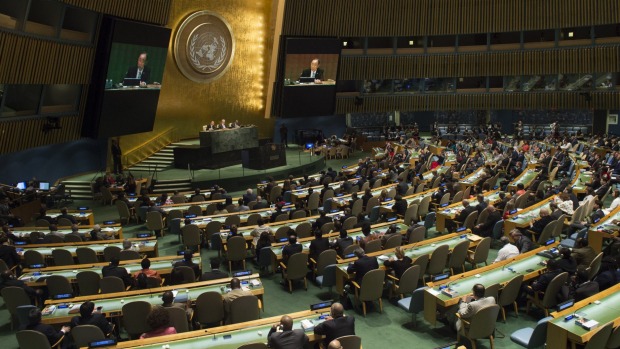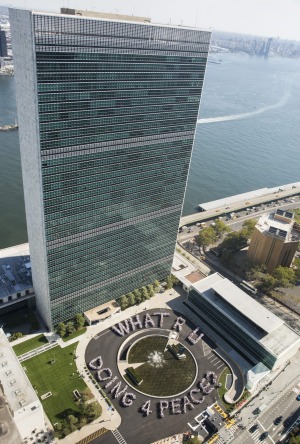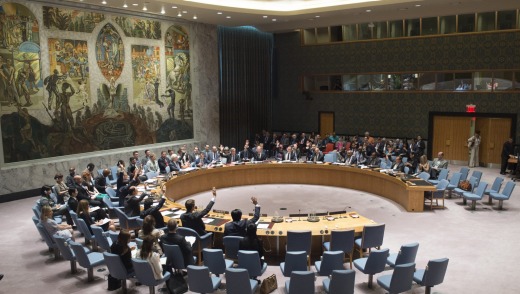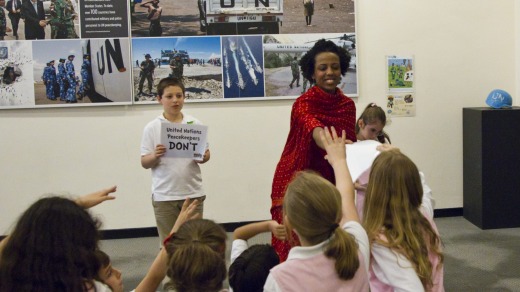
Never let it be said that the United Nations is averse to a spot of ham-fisted symbolism.
On the back wall of the UN Security Council Chamber, Per Krohg's mural starts all dark and grim at the bottom, with a bird emerging from the ashes. Further up, a couple gets married – representing hope for the future – and a horse prances in the supposed spirit of independence.
In front of it, a horseshoe of light blue seats stands empty, ready to welcome the ample backsides of the Security Council members who are about to enter and discuss the nuclear non-proliferation treaty.

Behind, a hive of interpreters prepares to translate everything into English, French, Spanish, Russian, Arabic and Mandarin.
The Security Council Chamber is deep inside the bloated belly of the UN's headquarters, which is technically international territory, but lies at the eastern edge of Manhattan.
The UN celebrates its 70th anniversary this year – it was founded on 24 October, 1945 – and the guided tours around its New York home are designed to shed light on what it does.

The guides are armed with plenty of information.
There are 120,000 peacekeepers around the world, with 70 different operations.
The Fill The Cup food program gives girls who attend 80 per cent of their school classes food to take home to their families.

The UNMAS operation removes landmines in countries from Haiti to Central African Republic.
The Universal Declaration of Human Rights is the most translated document in the world, although it has never been legally binding.
But the most interesting part of the well-meaning traipse around is how things work. The UN is a behemoth, and the main building – the somewhat unmissable Le Corbusier-designed blocky skyscraper that dominates the area – is purely for the administrative side of things. Around 5000 people work there.
Seating arrangements in the chambers are fraught with politics, too.
To stop bickering over who gets the best seats, the UN secretary-general picks a different country at the start of each session to take the first seat. The rest are seated in alphabetical order, according to their English name
The also-ran seats are perhaps more fascinating than those of the big boys. Some are predictable, such as the EU and the African Union, while the Vatican and Palestine have observer status, without full membership.
But the assorted oddities provoke some head-scratching. Malta has a spot next to the International Monetary Fund, for example.
Also wonderfully endearing is the bizarre collection of art, most of it donated by member states like grandmas doling out terrible jumpers at Christmas.
Outside, Italy has gifted a golden sphere that is split open to show what looks like industrial machinery. Luxembourg has weighed in with a gun that has its barrel twisted into a knot. And the framed rugs bearing portraits of former secretaries-general have been proudly sent by Iran.
Yet, inside the humungous General Assembly Hall are two splodgy, abstract murals by Frenchman Fernand Leger. They are, the guide explains, designed to show that lateral thinking and different perspectives are encouraged.
And, while it's easy to mock the UN on many levels, that's an admirable resolution.
www.visit.un.org
www.nycgo.com
United offers one-stop flights to New York from Sydney and Melbourne, via Los Angeles. See www.united.com.
UN tours cost around $28, and must be booked in advance via www.visit.un.org.
Langham Place is within easy walking distance, with doubles from $1000. See www.langhamhotels.com.
Check out symbolic art installations at the Franklin D. Roosevelt Four Freedoms Park on Roosevelt Island. See www.fdrfourfreedomspark.org.
Sample the amazing array of fruits, cheeses and meats on display at the historic market. See www.grandcentralterminal.com/market
Discover Japanese art and designs at the exhibitions hosted by the Japan Society. See www.japansociety.org.
Go for delicious Indian food in the Murray Hill neighbourhood.
See Edward Trumbull's gigantic ceiling painting, designed as a "celebration of energy and man's application of it to the solution of his problems".